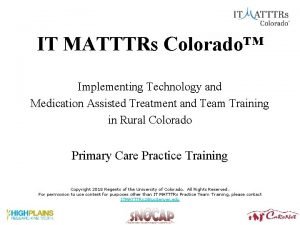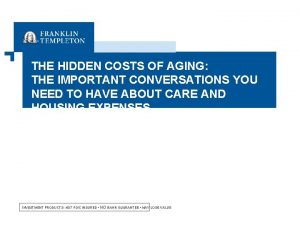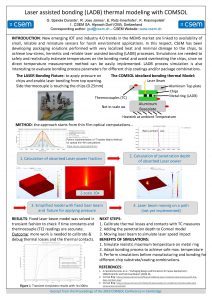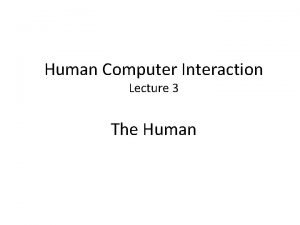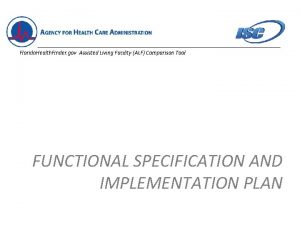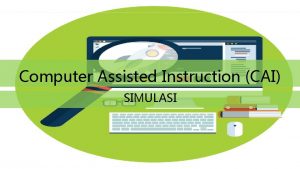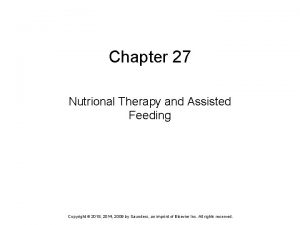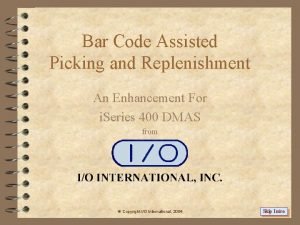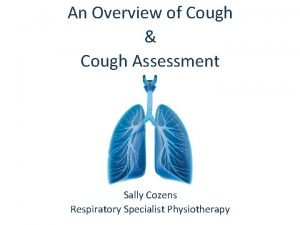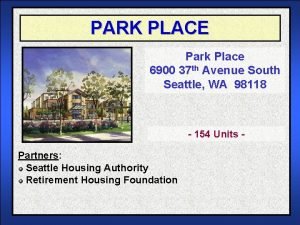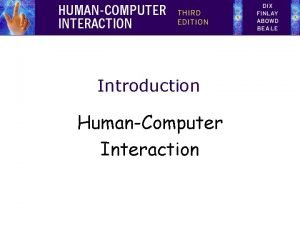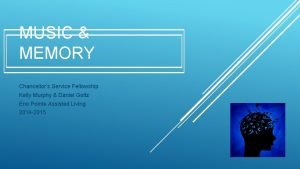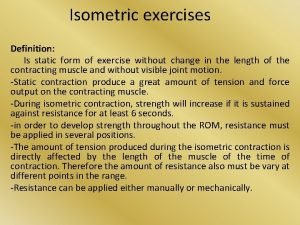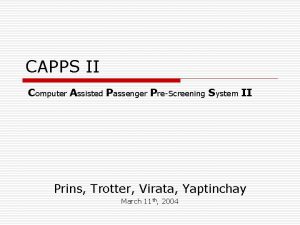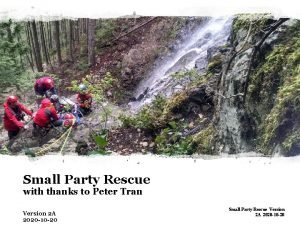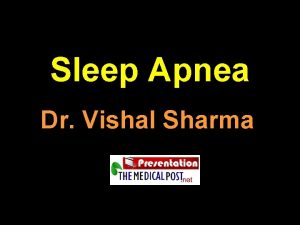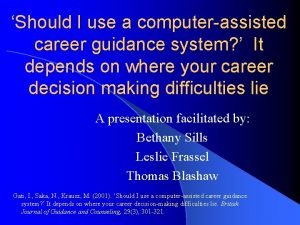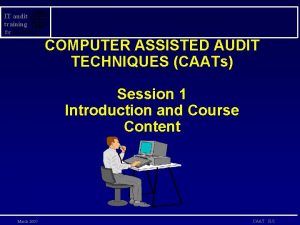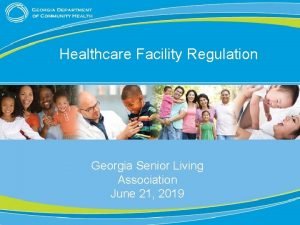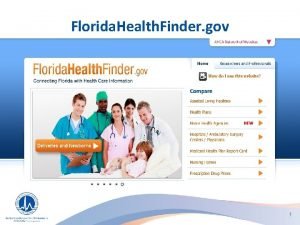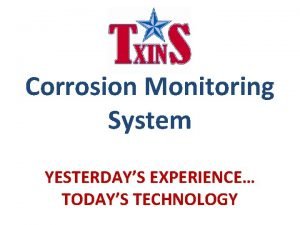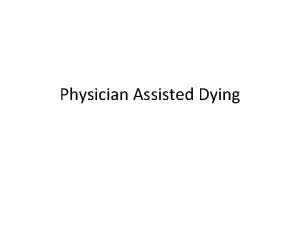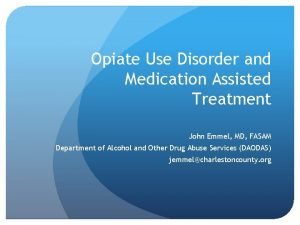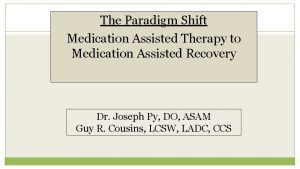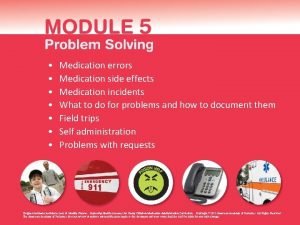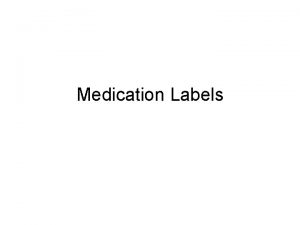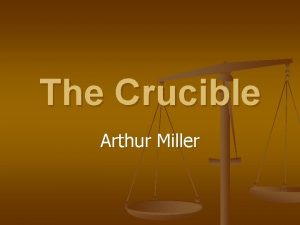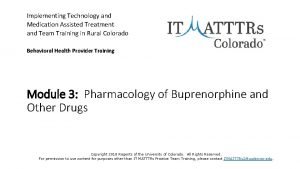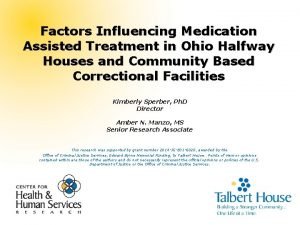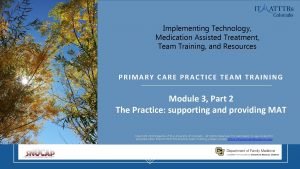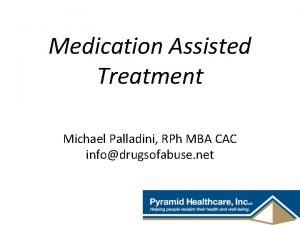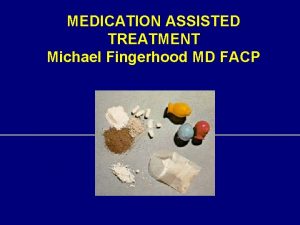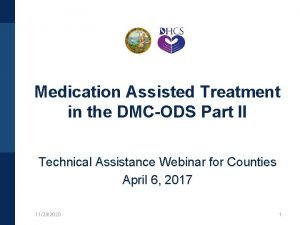Medication Assisted Treatment John Arthur Muenz Jr M

































- Slides: 33

Medication Assisted Treatment John Arthur Muenz, Jr. , M. D. , FAAPM&R, FABAM, FAAFP Family Care Partners jmuenz@familycarepartners. com

Disclosure I have no actual or potential conflict of interest in relation to this program/presentation.

Medication-assisted treatment (MAT) is the use of medications with counseling and behavioral therapies to treat substance use disorders and prevent opioid overdose.

Medication-Assisted Treatment (MAT) is the use of medications, in combination with counseling and behavioral therapies, to provide a “whole-patient” approach to the treatment of substance use disorders. Research shows that a combination of medication and therapy can successfully treat these disorders, and for some people struggling with addiction, MAT can help sustain recovery.

MAT is primarily used for the treatment of addiction to opiates such as heroin and prescription pain relievers that contain opioids.

The prescribed medication operates to normalize brain chemistry, block the euphoric effects of alcohol and opioids, relieve physiological cravings, and normalize body functions without the negative effects of the abused drug.

Medications used in MAT are approved by the Food and Drug Administration (FDA), and MAT programs are clinically driven and tailored to meet each patient’s needs.

In 2013, an estimated 2. 3 million people had an opioid use disorder related to prescription pain relievers or heroin. Outpatient MAT has proved to be clinically effective to significantly reduce the need for inpatient detoxification services. MAT provides a more comprehensive, individually tailored program of medication and behavioral therapy.

The ultimate goal of MAT is full recovery, including the ability to live a self-directed life. This treatment approach has been shown to: üImprove patient survival üIncrease retention in treatment üDecrease illicit opiate use and other criminal activity among people with substance use disorders üIncrease patients’ ability to gain and maintain employment üImprove birth outcomes among women who have substance use disorders and are pregnant

Unfortunately, MAT is greatly underused. The slow adoption of these evidence-based treatment options for alcohol and opioid dependence is partly due to misconceptions about substituting one drug for another. Discrimination against MAT patients is also a factor, despite state and federal laws clearly prohibiting it. Other factors include lack of training for physicians and negative opinions toward MAT in communities and among health care professionals.

A common misconception associated with MAT is that it substitutes one drug for another. Instead, these medications relieve the withdrawal symptoms and psychological cravings that cause chemical imbalances in the body. MAT programs provide a safe and controlled level of medication to overcome the use of an abused opioid.

Medications Used in MAT FDA has approved several different medications to treat opioid addiction and alcohol dependence. ØMethadone ØBuprenorphine ØNaltrexone

§Methadone used in MAT for opioid treatment can only be dispensed through a SAMHSAcertified OTP. §Buprenorphine/naloxone can only prescribed by DEA waivered providers. §Naltrexone certification. be needs no special waiver or

Opioid Dependency Medications Methadone, buprenorphine, and naltrexone are used to treat opioid dependence and addiction to opioids such as heroin, morphine, and codeine, as well as semi -synthetic opioids like oxycodone and hydrocodone. People may safely take medications used in MAT for months, years, several years, or even a lifetime. Plans to stop a medication must always be discussed with a doctor.

Methadone has been used for decades to treat people who are addicted to heroin and narcotic pain medicines. For optimal results, patients should also participate in a comprehensive medication-assisted treatment (MAT) program that includes counseling and social support.

Methadone It lessens the painful symptoms of opiate withdrawal and blocks the euphoric effects of opiate drugs such as heroin, morphine, and codeine, as well as semi-synthetic opioids like oxycodone and hydrocodone. Methadone is offered in pill, liquid, and wafer forms and is taken once a day. Patients taking methadone to treat opioid addiction must receive the medication under the supervision of a physician in a Federally Certified Program. By law, methadone can only be dispensed through an opioid treatment program (OTP) certified by SAMHSA.

Buprenorphine Like methadone, buprenorphine suppresses and reduces cravings for the abused drug. It can come in a pill form or sublingual tablet that is placed under the tongue. Approved for clinical use in October 2002 by the Food and Drug Administration (FDA), buprenorphine represents the latest advance in medication-assisted treatment (MAT). Medications such as buprenorphine, in combination with counseling and behavioral therapies, provide a whole-patient approach to the treatment of opioid dependency. When taken as prescribed, buprenorphine is safe and effective.

Buprenorphine Unlike methadone treatment, which must be performed in a highly structured clinic, buprenorphine is the first medication to treat opioid dependency that is permitted to be prescribed or dispensed in physician offices, significantly increasing treatment access. Under the Drug Addiction Treatment of 2000 (DATA 2000) qualified U. S. physicians can offer buprenorphine for opioid dependency in various settings, including in an office, community hospital, health department, or correctional facility.

Buprenorphine offers several benefits to those with opioid dependency and to others for whom treatment in a methadone clinic is not preferred or is less convenient. The FDA has approved the following buprenorphine products: o. Bunavail (buprenorphine and naloxone) buccal film o. Suboxone (buprenorphine and naloxone) film o. Zubsolv (buprenorphine and naloxone) sublingual tablets o. Buprenorphine-containing transmucosal products for opioid dependency

Buprenorphine has unique pharmacological properties that help: • Lower the potential for misuse • Diminish the effects of physical dependency to opioids, such as withdrawal symptoms and cravings • Increase safety in cases of overdose

Training on Providing Buprenorphine • Buprenorphine as an opioid use disorder treatment is carefully regulated. Qualified physicians are required to acquire and maintain certifications to legally dispense or prescribe opioid dependency medications. SAMHSA’s Division of Pharmacologic Therapies (DPT) makes available required buprenorphine training for physicians, webinars, workshops and summits and publications and research.

Buprenorphine • The opioid effects increase with each dose until, at moderate doses, they level off, even with further dose increases. This “ceiling effect” lowers the risk of misuse, dependency, and side effects. Also, because of buprenorphine’s long-acting agent, many patients may not have to take it every day. • It is an opioid partial agonist at the mu receptor. This means that, like opioids, it produces effects such as euphoria or respiratory depression. With buprenorphine, however, these effects are weaker than those of full agonists, drugs such as heroin and methadone.

Naltrexone works differently than methadone and buprenorphine in the treatment of opioid dependency. If a person using naltrexone relapses and uses the abused drug, naltrexone blocks the euphoric and sedative effects of the abused drug and prevents feelings of euphoria.

Naltrexone blocks the euphoric and sedative effects of drugs such as heroin, morphine, and codeine, as well as the semi-synthetic opioids, like oxycodone. It works differently in the body than buprenorphine and methadone, which activate opioid receptors in the body that suppress cravings. Naltrexone binds and blocks opioid receptors, and to reduce opioid cravings. There is no abuse and diversion potential with naltrexone. If a person relapses and uses the problem drug, naltrexone prevents the feeling of getting high. People using naltrexone should not use any other opioids or illicit drugs; drink alcohol; or take sedatives, tranquilizers, or other drugs.

Naltrexone Patients on naltrexone may have reduced tolerance to opioids and may be unaware of their potential sensitivity to the same, or lower, doses of opioids that they used to take. If patients who are treated with naltrexone relapse after a period of abstinence, it is possible that the dosage of opioid that was previously used may have life-threatening consequences, including respiratory arrest and circulatory collapse. As with all medications used in medication assisted treatment (MAT) naltrexone is to be prescribed as part of a comprehensive treatment plan that includes counseling and participation in social support programs.

Naltrexone for Opioid Use Disorders Extended-release injectable naltrexone is approved for treatment of people with opioid use disorder. It can be prescribed by any healthcare provider who is licensed to prescribe medications, special training is not required. It is important that medical managed withdrawal (detoxification) from opioids be completed at least 7 to 10 days before extended-release injectable naltrexone is initiated or resumed. Research has shown that naltrexone decreases reactivity to drugconditioned cues and decreases craving.

Naltrexone for Alcohol Dependence When used as a treatment for alcohol dependency, naltrexone blocks the euphoric effects and feelings of intoxication. This allows people with alcohol dependence to reduce their drinking behaviors enough to remain motivated to stay in treatment and avoid relapses. Naltrexone is not addictive nor does it react adversely with alcohol. Long-term naltrexone therapy extending beyond three months is considered most effective by researchers, and therapy may also be used indefinitely.

Side Effects of Naltrexone People taking naltrexone may experience side effects, but they should not stop taking the medication. Instead, they should consult their health care provider or substance misuse treatment practitioner to adjust the dose or change the medication. Some side effects include: Upset stomach or vomiting Diarrhea Headache Nervousness Sleep problems/tiredness Joint or muscle pain

Alcohol Use Disorder Medications Disulfiram, Acamprosate, and naltrexone are the most common drugs used to treat alcohol use disorder. None of these drugs provide a cure for the disorder, but they are most effective in people who participate in a MAT program.

Disulfiram (Antabuse) Disulfiram is a medication that treats chronic alcoholism. It is most effective in people who have already gone through detoxification or are in the initial stage of abstinence. This drug is offered in a tablet form and is taken once a day. Disulfiram should never be taken while intoxicated and it should not be taken for at least 12 hours after drinking alcohol. Unpleasant side effects (nausea, headache, vomiting, chest pains, difficulty breathing) can occur as soon as ten minutes after drinking even a small amount of alcohol and can last for an hour or more.

Acamprosate (Campral) Acamprosate is a medication for people in recovery who have already stopped drinking alcohol and want to avoid drinking. It works to prevent people from drinking alcohol, but it does not prevent withdrawal symptoms after people drink alcohol. It has not been shown to work in people who continue drinking alcohol, consume illicit drugs, and/or engage in prescription drug misuse and abuse. The use of Acamprosate typically begins on the fifth day of abstinence, reaching full effectiveness in five to eight days. It is offered in tablet form and taken three times a day, preferably at the same time every day. The medication’s side effects may include diarrhea, upset stomach, appetite loss, anxiety, dizziness, and difficulty sleeping.

Naltrexone (Revia) When used as a treatment for alcohol dependency, naltrexone blocks the euphoric effects and feelings of intoxication. This allows people with alcohol addiction to reduce their drinking behaviors enough to remain motivated to stay in treatment, avoid relapses, and take medications.

Resources • • Substance Abuse and Mental Health Services Administration 5600 Fishers Lane Rockville, MD 20857 (877 -SAMHSA-7 (877 -726 -4727 www. SAMHSA. gov The Substance Abuse and Mental Health Services Administration (SAMHSA) is the agency within the U. S. Department of Health and Human Services that leads public health efforts to advance the behavioral health of the nation. SAMHSA's mission is to reduce the impact of substance abuse and mental illness on America's communities.
 Medication assisted treatment colorado
Medication assisted treatment colorado John arthur world hunger and moral obligation
John arthur world hunger and moral obligation Define computer assisted language learning
Define computer assisted language learning Hidden costs of assisted living
Hidden costs of assisted living Robot assisted surgery
Robot assisted surgery Microwave assisted extraction
Microwave assisted extraction Laser assisted bonding
Laser assisted bonding Is the information is lost gradually but very slowly.
Is the information is lost gradually but very slowly. Florida facility finder
Florida facility finder Advantages of call
Advantages of call Contoh computer assisted instruction
Contoh computer assisted instruction Chapter 27 nutritional therapy and assisted feeding
Chapter 27 nutritional therapy and assisted feeding Assisted picking
Assisted picking Manual assisted cough
Manual assisted cough Sequence of service banquet
Sequence of service banquet What part
What part 254 park place
254 park place Information reproduced from memory can be assisted by cues.
Information reproduced from memory can be assisted by cues. Nih assisted referral tool
Nih assisted referral tool Hardware assisted virtualization in cloud computing
Hardware assisted virtualization in cloud computing Eno pointe assisted living reviews
Eno pointe assisted living reviews Isometric exercise definition
Isometric exercise definition Computer assisted passenger prescreening system
Computer assisted passenger prescreening system Thanks for the rescue
Thanks for the rescue Linguloplasty
Linguloplasty Computer assisted guidance systems
Computer assisted guidance systems Peer assisted
Peer assisted Online proctored exams candidate guidelines peoplecert
Online proctored exams candidate guidelines peoplecert Caats adalah
Caats adalah Georgia assisted living association
Georgia assisted living association Home health finder
Home health finder Hydrogen assisted cracking
Hydrogen assisted cracking Computer aided teaching and testing
Computer aided teaching and testing Sabal palm assisted living palm coast
Sabal palm assisted living palm coast
